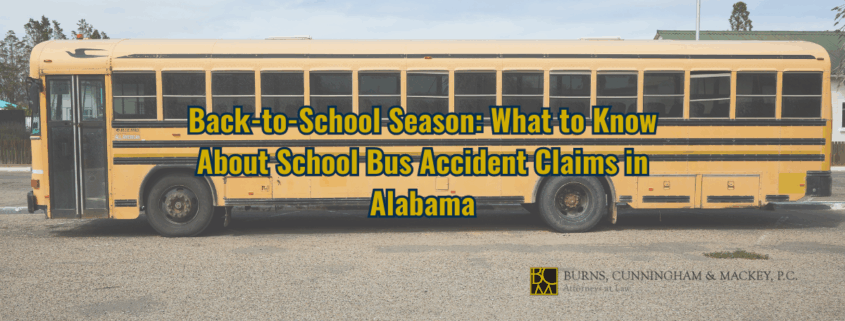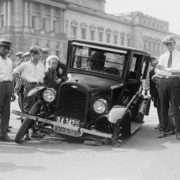Back-to-School Season: What to Know About School Bus Accident Claims in Alabama
As summer days give way to cooler mornings, the familiar sight of yellow school buses reappears on Alabama roads. For parents, this marks a return to routine, but it also brings a renewed focus on child safety. While school buses are generally considered a safe mode of transportation, accidents do happen. When they involve a child, the situation can be terrifying, and the legal path forward can feel overwhelming.
What Are the Common Causes of School Bus Accidents?
School bus accidents, while relatively rare compared to other vehicle collisions, can occur for a variety of reasons. Pinpointing the exact cause is a key step in any claim.
Driver Negligence: This is a broad category that can include many factors.
- Distracted Driving: A bus driver might be distracted by a cell phone, passengers, or even something outside the bus.
- Fatigue: Long hours or insufficient rest can impair a driver’s reaction time and judgment.
- Driving Under the Influence: Although rare, a bus driver operating under the influence of drugs or alcohol is a severe form of negligence.
- Speeding: Exceeding the speed limit, especially in residential or school zones, significantly increases accident risk.
- Improper Turns or Lane Changes: Large vehicles like school buses require extra caution and skill in maneuvering.
- Failure to Obey Traffic Laws: Running stop signs, red lights, or failing to yield can lead to devastating collisions.
Improper Bus Maintenance: A school bus must be regularly inspected and maintained to ensure safe operation.
- Brake Failure: Worn-out brake pads or faulty brake lines can lead to a loss of stopping power.
- Tire Blowouts: Defective or improperly inflated tires can cause a bus to lose control.
- Steering System Malfunctions: Issues with the steering mechanism can make the bus difficult to control.
- Lighting or Signal Problems: Non-functioning headlights, brake lights, or turn signals reduce visibility and communication with other drivers.
Third-Party Driver Negligence: Often, another driver on the road is at fault for colliding with a school bus.
- Aggressive Driving: Drivers who speed, tailgate, or weave through traffic can cause multi-vehicle accidents.
- Distracted Driving: A passenger vehicle driver looking at their phone or otherwise inattentive can hit a bus.
- DUI/DWI: Impaired drivers pose a significant risk to all road users, including school buses and their occupants.
- Failure to Stop for a Stopped School Bus: Drivers illegally passing a stopped school bus with its stop arm extended and lights flashing is a major cause of pedestrian-related injuries to children.
Road Conditions or Environmental Factors:
- Poor Weather: Rain, ice, snow, or fog can make roads hazardous, requiring drivers to adjust their speed and caution.
- Road Defects: Potholes, uneven pavement, or insufficient signage can contribute to accidents.
- Construction Zones: Unsafe or poorly marked construction areas can create dangerous situations.
Manufacturing Defects: In rare cases, a defect in the bus’s design or manufacturing could contribute to an accident. This might involve faulty parts, structural weaknesses, or issues with safety features.
Identifying the cause of a school bus accident often requires a detailed investigation, including reviewing accident reports, bus maintenance logs, driver records, witness statements, and sometimes accident reconstruction.
What Specific Challenges Arise in Child Injury Claims from School Bus Accidents?
When a child is injured in a school bus accident, the legal process becomes more intricate than a typical adult personal injury claim. Special rules and considerations are in place to safeguard the child’s interests.
Legal Capacity of a Minor: Children lack the legal authority to file a lawsuit or make binding legal decisions on their own. Therefore, an adult must act on their behalf.
- “Next Friend” Requirement: The claim or lawsuit must be filed by a parent, legal guardian, or another suitable adult designated as the child’s “next friend.” This individual is responsible for overseeing the legal proceedings in the child’s best interests.
- Court Approval for Settlements: Any settlement involving a minor’s injury claim must be approved by a judge. This process, known as a “pro ami” settlement, ensures the agreement is fair, reasonable, and truly benefits the child. A hearing is typically held where the judge reviews all aspects of the proposed settlement.
Role of a Guardian ad Litem (GAL): In many Alabama child injury cases, especially those involving significant settlements, the court will appoint a Guardian ad Litem.
- Independent Investigation: The GAL is an attorney whose role is to independently investigate the case, review the proposed settlement, and determine if it serves the child’s best interests.
- Recommendation to the Court: The GAL provides a report and recommendation to the judge, which carries substantial weight in the court’s decision to approve or deny a settlement.
Determining Damages for a Child’s Future: Calculating compensation for a child’s injury is complex because it often involves projecting long-term impacts.
- Future Medical Needs: A child’s injuries might require ongoing medical care for years, even decades. This includes future surgeries, therapies, medications, and specialized equipment.
- Lost Earning Capacity: If a permanent injury affects a child’s ability to work in the future, vocational experts and economists may be needed to estimate the loss of potential lifetime earnings. This is a highly speculative but vital component of damages.
- Long-Term Pain and Suffering: Quantifying a child’s ongoing physical pain, emotional distress, and diminished quality of life for the rest of their life is a delicate and challenging task.
Statute of Limitations Tolling: Alabama law provides a special rule for minors regarding the statute of limitations.
- Extended Deadline: While most personal injury claims have a two-year statute of limitations, for minors, this period is “tolled” or paused until the child turns 19 (the age of majority in Alabama). This generally means a child has until their 21st birthday to file a lawsuit.
- Importance of Prompt Action: Despite the extended deadline, delaying action is generally not advisable. Key evidence can be lost, and witness memories fade over time, making it harder to build a strong case.
Navigating these unique challenges requires legal guidance from someone familiar with Alabama’s specific laws regarding minors’ claims.
Who Can Be Held Liable in an Alabama School Bus Accident?
Identifying all potentially responsible parties is a critical step in a school bus accident claim. Liability can extend beyond just the bus driver.
The School Bus Driver: If the accident resulted from the driver’s negligence, they are often a primary party. This includes actions like distracted driving, speeding, failing to follow traffic laws, or improper vehicle operation.
The School District or Bus Company: This entity is often held responsible for the actions of its employees, including bus drivers, under a legal principle known as “respondeat superior.” Their liability can also stem from:
- Negligent Hiring: Failing to conduct proper background checks or hiring unqualified drivers.
- Negligent Training: Not providing adequate training on defensive driving, safety procedures, or emergency protocols.
- Negligent Supervision: Failing to monitor driver performance or address known issues.
- Negligent Maintenance: Failing to properly inspect or maintain the buses, leading to mechanical failures.
Other Drivers: If another vehicle collided with the school bus due to that driver’s negligence, that driver and their insurance company can be held liable. This is a common scenario where a distracted, impaired, or reckless driver causes the accident.
Bus Manufacturer: In cases where a mechanical defect or design flaw in the bus itself contributed to the accident, the bus manufacturer could be named as a defendant in a product liability claim. This requires a thorough investigation by automotive engineers and product safety experts.
Parts Manufacturers: Similarly, if a specific component within the bus (e.g., brakes, tires, steering system) failed due to a defect, the manufacturer of that part could be held responsible.
Maintenance Companies: If the school district or bus company outsourced its maintenance, and poor maintenance contributed to the accident, the third-party maintenance company could be liable.
Governmental Entities: Because school districts are often governmental entities, claims against them can be subject to specific rules and immunities, such as Alabama’s caps on damages against municipalities. Navigating these rules requires a nuanced approach.
A comprehensive investigation is always necessary to identify every party that contributed to the accident and therefore shares responsibility for the child’s injuries.
What Types of Injuries Are Common in School Bus Accidents?
While safety features are built into school buses, the sheer force of a collision can still result in severe and life-altering injuries, particularly for children whose bodies are more vulnerable.
- Head Injuries and Traumatic Brain Injuries (TBI): Even a seemingly minor bump to the head can have serious consequences for a child. More severe impacts can cause concussions, contusions, or diffuse axonal injuries. Symptoms can range from headaches and dizziness to cognitive difficulties, personality changes, and seizures.
- Spinal Cord Injuries: The back and neck are highly susceptible to injury in a collision. These can range from whiplash and herniated discs to more catastrophic spinal cord damage leading to partial or complete paralysis (paraplegia or quadriplegia).
- Bone Fractures: Broken bones are common, particularly in the limbs, ribs, or skull. The severity can vary from simple breaks to complex, comminuted fractures that require multiple surgeries and extensive rehabilitation.
- Internal Organ Damage: The impact of a crash can cause blunt force trauma to internal organs such as the spleen, kidneys, liver, or lungs, leading to internal bleeding, organ dysfunction, or rupture.
- Soft Tissue Injuries: Sprains, strains, and tears to muscles, ligaments, and tendons are very common. While seemingly less severe, they can lead to chronic pain and long-term mobility issues if not properly treated.
- Lacerations and Abrasions: Broken glass, twisted metal, or impact with interior components can cause cuts and scrapes, which may require stitches and result in permanent scarring.
- Dental Injuries: Impacts can lead to chipped, fractured, or lost teeth, requiring extensive and costly dental work, especially for developing permanent teeth.
- Emotional and Psychological Trauma: Beyond physical injuries, children involved in accidents often suffer significant emotional distress. This can manifest as anxiety, fear of riding in vehicles, nightmares, behavioral changes, or Post-Traumatic Stress Disorder (PTSD). Psychological counseling is often a vital part of their recovery.
The long-term effects of these injuries on a growing child, including their development, education, and overall quality of life, must be carefully considered when evaluating a claim.
What Steps Should Parents Take After a School Bus Accident?
The moments following a school bus accident can be chaotic and frightening, but taking certain steps can help protect your child’s rights and future claims.
Prioritize Safety and Medical Attention
- Ensure Immediate Safety: If you are at the scene, ensure your child is moved to a safe location away from traffic or hazards.
- Seek Medical Evaluation: Even if injuries do not appear obvious, have your child examined by a medical professional as soon as possible. Some injuries, especially head injuries, may not manifest symptoms immediately. A medical record from soon after the accident is important documentation.
- Follow All Medical Advice: Ensure your child attends all follow-up appointments, completes prescribed therapies, and takes all medications as directed. Consistent medical care is vital for their recovery and for documenting the extent of their injuries.
Gather Information at the Scene (If Possible and Safe)
- Contact Information: Obtain contact details from the bus driver, school officials, and any other drivers involved.
- Witness Information: Collect names and phone numbers of anyone who witnessed the accident. Their unbiased accounts can be invaluable.
- Photos and Videos: Use your phone to take pictures or videos of the accident scene, vehicle damage, road conditions, traffic signs, and any visible injuries to your child.
- Police Report: Get the police report number and the name of the investigating officer. The police report will contain preliminary findings about the accident.
Report the Accident
- Notify the School/School District: Inform the school administration and the transportation department about the accident and your child’s injuries.
- Notify Your Insurance Company: Even if your child was a passenger, inform your own insurance company (auto or health) about the accident.
Keep Meticulous Records
- Medical Records: Keep all medical bills, doctor’s notes, therapy records, and prescription details.
- Accident-Related Expenses: Document any other costs related to the accident, such as transportation to appointments, missed school days, or assistive devices.
- Journals: Consider keeping a journal detailing your child’s symptoms, pain levels, emotional state, and how the injuries are affecting their daily life, school, and activities.
Avoid Making Statements to Insurance Companies
- Be Cautious: Do not give recorded statements to the at-fault party’s insurance company without legal guidance. They may try to minimize your child’s injuries or trick you into saying something that could harm the claim.
- Do Not Accept Early Settlement Offers: Initial offers from insurance companies are almost always far below the true value of a child’s claim, especially when long-term care is a factor.
Seek Legal Guidance:
- Consult with an Attorney: An attorney can provide vital guidance from the outset, helping you navigate the complex legal landscape of child injury claims, dealing with insurance companies, and ensuring all deadlines are met.
- Specific Alabama Laws: Given Alabama’s contributory negligence rule and special provisions for minors, legal advice specific to your situation is important.
Taking these steps diligently will help build a strong foundation for your child’s claim and ensure their rights are fully protected.













Leave a Reply
Want to join the discussion?Feel free to contribute!